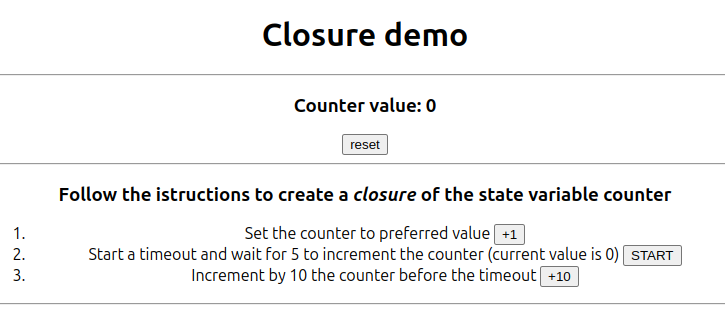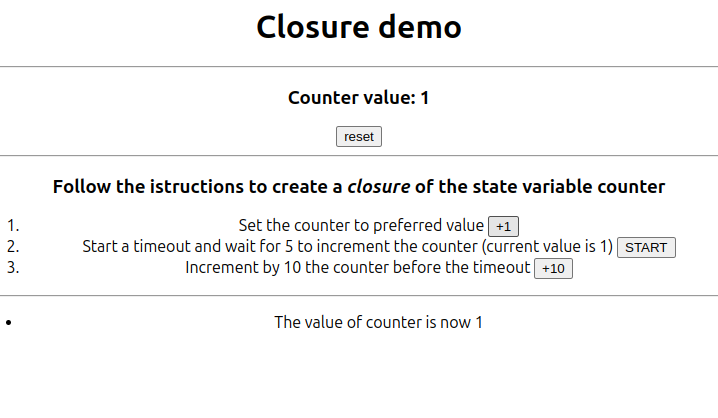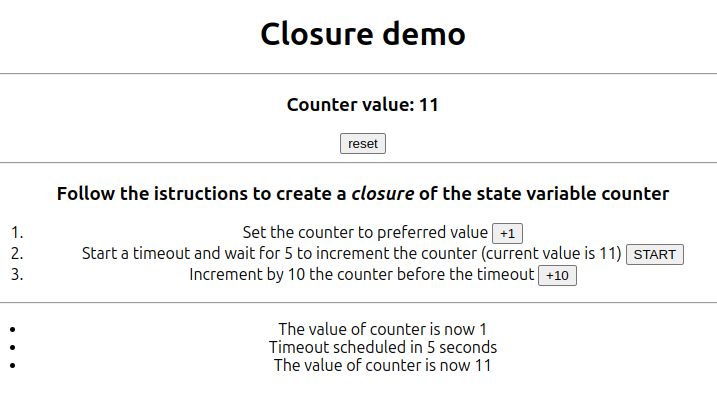React: 古いクロージャ
この投稿では、useState フック React アプリでクロージャーを作成する方法を示します。
クロージャとは何かについては説明しません。このトピックに関するリソースは数多くあり、繰り返しになることは避けたいからです。 @imranabdulmalik によるこの記事を読むことをお勧めします。
要するに、クロージャは (Mozilla から):
です。...一緒にバンドルされた (囲まれた) 関数とその周囲の状態 (語彙環境) への参照の組み合わせ。言い換えれば、クロージャを使用すると、内部関数から外部関数のスコープにアクセスできるようになります。 JavaScript では、関数が作成されるたびに、関数の作成時にクロージャが作成されます.
語彙環境という用語に慣れていない場合に備えて、@soumyadey によるこの記事、またはこの記事を読むことができます。
問題
React アプリケーションでは、useState フックで作成されたコンポーネントの状態に属する変数のクロージャーを誤って作成してしまう可能性があります。これが発生すると、古いクロージャの問題に直面することになります。つまり、状態の古い値を参照すると、その間に値が変更され、関連性が低くなります。
]POC
Demo React アプリケーションを作成しました。その主な目的は、setTimeout メソッドのコールバック内のクロージャで閉じることができる (状態に属する) カウンターをインクリメントすることです。
つまり、このアプリは次のことができます:
- カウンタの値を表示
- カウンタを 1 増やす
- 5 秒後にカウンターを 1 つ増やすタイマーを開始します。
- カウンターを 10 増やす
次の図では、カウンターが 0 の、アプリの初期 UI 状態が示されています。

カウンターの閉鎖を 3 つのステップでシミュレートします:
- カウンタを 1 増やす

- 5 秒後に 1 ずつ増加するタイマーを開始します

- タイムアウトがトリガーされる前に 10 ずつ増加します

5 秒後、カウンターの値は 2 になります。

カウンターの期待値は 12 であるはずですが、2 が得られます。
これが発生する理由は、setTimeout に渡されるコールバック内で カウンタのクロージャ を作成し、タイムアウトがトリガーされたときにそのカウンタから開始してカウンタを設定したためです。古い値 (1 でした)。
setTimeout(() => {
setLogs((l) => [...l, `You closed counter with value: ${counter}\n and now I'll increment by one. Check the state`])
setTimeoutInProgress(false)
setStartTimeout(false)
setCounter(counter 1)
setLogs((l) => [...l, `Did you create a closure of counter?`])
}, timeOutInSeconds * 1000);
アプリ コンポーネントの完全なコードに従います。
function App() {
const [counter, setCounter] = useState(0)
const timeOutInSeconds: number = 5
const [startTimeout, setStartTimeout] = useState(false)
const [timeoutInProgress, setTimeoutInProgress] = useState(false)
const [logs, setLogs] = useState>([])
useEffect(() => {
if (startTimeout && !timeoutInProgress) {
setTimeoutInProgress(true)
setLogs((l) => [...l, `Timeout scheduled in ${timeOutInSeconds} seconds`])
setTimeout(() => {
setLogs((l) => [...l, `You closed counter with value: ${counter}\n and now I'll increment by one. Check the state`])
setTimeoutInProgress(false)
setStartTimeout(false)
setCounter(counter 1)
setLogs((l) => [...l, `Did you create a closure of counter?`])
}, timeOutInSeconds * 1000);
}
}, [counter, startTimeout, timeoutInProgress])
function renderLogs(): React.ReactNode {
const listItems = logs.map((log, index) =>
{log}
);
return {listItems}
;
}
function updateCounter(value: number) {
setCounter(value)
setLogs([...logs, `The value of counter is now ${value}`])
}
function reset() {
setCounter(0)
setLogs(["reset done!"])
}
return (
Closure demo
Counter value: {counter}
Follow the istructions to create a closure of the state variable counter
- Set the counter to preferred value
- Start a timeout and wait for {timeOutInSeconds} to increment the counter (current value is {counter})
- Increment by 10 the counter before the timeout
{
renderLogs()
}
);
}
export default App;
解決
この解決策は、レンダリングに必要のない値を参照できる useRef フックの使用に基づいています。
そこで、App コンポーネントに追加します:
const currentCounter = useRef(counter)
次に、setTimeout のコールバックを以下のように変更します。
setTimeout(() => {
setLogs((l) => [...l, `You closed counter with value: ${currentCounter.current}\n and now I'll increment by one. Check the state`])
setTimeoutInProgress(false)
setStartTimeout(false)
setCounter(currentCounter.current 1)
setLogs((l) => [...l, `Did you create a closure of counter?`])
}, timeOutInSeconds * 1000);
現在の値をインクリメントする前にログに記録するため、コールバックはカウンター値を読み取る必要があります。
値を読み取る必要がない場合は、関数表記を使用してカウンターを更新するだけでカウンターのクローズを回避できます。
seCounter(c => c 1)
リソース
- Dmitri Pavlutin React フックを使用するときは古いクロージャに注意する
- Imran Abdulmalik JavaScript でクロージャをマスターする: 包括的なガイド
- JavaScript の Keyur Paralkar 語彙スコープ – 初心者ガイド
- React での Souvik Paul の古いクロージャー
- Soumya Dey JavaScript における語彙のスコープとクロージャの理解
- スバシュ・マハパトラ スタックオーバーフロー
-
 ハクトーバーフェストに貢献する新しい方法: フロントエンド AI で直接Hacktoberfest が帰ってきます。今年は開発者が参加できるエキサイティングな新しい方法をもたらします。 従来の GitHub プル リクエストの代わりに、Webcrumbs プラットフォーム上のフロントエンド AI を通じて直接テンプレートを作成して送信できるようになりました。 tools...プログラミング 2024 年 11 月 7 日に公開
ハクトーバーフェストに貢献する新しい方法: フロントエンド AI で直接Hacktoberfest が帰ってきます。今年は開発者が参加できるエキサイティングな新しい方法をもたらします。 従来の GitHub プル リクエストの代わりに、Webcrumbs プラットフォーム上のフロントエンド AI を通じて直接テンプレートを作成して送信できるようになりました。 tools...プログラミング 2024 年 11 月 7 日に公開 -
 関数ポインタが括弧なしで使用されると、「cout」に「1」が出力されるのはなぜですか?なぜ「関数を呼び出さずに関数を出力します (f() ではなく f;)。常に 1 を出力しますか?」この中でこのコードでは、括弧を使用せずに pr という名前の関数を「呼び出し」ようとします。ただし、これは実際には関数を呼び出しているわけではありません。代わりに、関数ポインタを cout 関数に渡しま...プログラミング 2024 年 11 月 7 日に公開
関数ポインタが括弧なしで使用されると、「cout」に「1」が出力されるのはなぜですか?なぜ「関数を呼び出さずに関数を出力します (f() ではなく f;)。常に 1 を出力しますか?」この中でこのコードでは、括弧を使用せずに pr という名前の関数を「呼び出し」ようとします。ただし、これは実際には関数を呼び出しているわけではありません。代わりに、関数ポインタを cout 関数に渡しま...プログラミング 2024 年 11 月 7 日に公開 -
 Web ページを高速化するDOM とは何ですか?それは何を食べるのでしょうか? DOM (Document Object Model) は Web ページとその開発の基礎です。これは、HTML および XML ドキュメント用のプログラミング インターフェイスであり、ドキュメントの構造をツリー状のオブジェクト...プログラミング 2024 年 11 月 7 日に公開
Web ページを高速化するDOM とは何ですか?それは何を食べるのでしょうか? DOM (Document Object Model) は Web ページとその開発の基礎です。これは、HTML および XML ドキュメント用のプログラミング インターフェイスであり、ドキュメントの構造をツリー状のオブジェクト...プログラミング 2024 年 11 月 7 日に公開 -
 JavaScript での require と importコーディングを始めたとき、require() を使用してモジュールやインポートを使用して他のファイルをインポートするいくつかの js ファイルを見たことを覚えています。何が違うのか、なぜプロジェクト間で一貫性がないのかがよくわからず、いつも混乱していました。同じことを疑問に思っている場合は、読み続け...プログラミング 2024 年 11 月 7 日に公開
JavaScript での require と importコーディングを始めたとき、require() を使用してモジュールやインポートを使用して他のファイルをインポートするいくつかの js ファイルを見たことを覚えています。何が違うのか、なぜプロジェクト間で一貫性がないのかがよくわからず、いつも混乱していました。同じことを疑問に思っている場合は、読み続け...プログラミング 2024 年 11 月 7 日に公開 -
 イメージを使用した Vite/React アプリケーションのデプロイ: 完全ガイドVite/React アプリケーションを GitHub Pages にデプロイすることはエキサイティングなマイルストーンですが、このプロセスでは、特に画像やアセットを扱う場合、予期せぬ課題が発生することがあります。このブログ投稿では、初期導入から一般的な問題のトラブルシューティング、効果的な解決策の...プログラミング 2024 年 11 月 7 日に公開
イメージを使用した Vite/React アプリケーションのデプロイ: 完全ガイドVite/React アプリケーションを GitHub Pages にデプロイすることはエキサイティングなマイルストーンですが、このプロセスでは、特に画像やアセットを扱う場合、予期せぬ課題が発生することがあります。このブログ投稿では、初期導入から一般的な問題のトラブルシューティング、効果的な解決策の...プログラミング 2024 年 11 月 7 日に公開 -
 React アプリで API 呼び出しを最適化した方法React 開発者として、私たちは、複数の急速な状態変化を API と同期する必要があるシナリオによく直面します。小さな変更ごとに API 呼び出しを行うのは非効率的であり、クライアントとサーバーの両方に負担がかかる可能性があります。ここで、デバウンスと賢明な状態管理が機能します。この記事では、ペイ...プログラミング 2024 年 11 月 7 日に公開
React アプリで API 呼び出しを最適化した方法React 開発者として、私たちは、複数の急速な状態変化を API と同期する必要があるシナリオによく直面します。小さな変更ごとに API 呼び出しを行うのは非効率的であり、クライアントとサーバーの両方に負担がかかる可能性があります。ここで、デバウンスと賢明な状態管理が機能します。この記事では、ペイ...プログラミング 2024 年 11 月 7 日に公開 -
 PNG 画像を CSS データ URI の Base64 としてエンコードするにはどうすればよいですか?CSS データ URI の PNG 画像に Base64 エンコーディングを使用するデータ URI を使用して PNG 画像を CSS スタイルシートに埋め込むには、PNG データ最初に Base64 形式にエンコードする必要があります。この手法を使用すると、外部画像ファイルをスタイルシート内に直接...プログラミング 2024 年 11 月 6 日に公開
PNG 画像を CSS データ URI の Base64 としてエンコードするにはどうすればよいですか?CSS データ URI の PNG 画像に Base64 エンコーディングを使用するデータ URI を使用して PNG 画像を CSS スタイルシートに埋め込むには、PNG データ最初に Base64 形式にエンコードする必要があります。この手法を使用すると、外部画像ファイルをスタイルシート内に直接...プログラミング 2024 年 11 月 6 日に公開 -
 API 時間別データの応答性の高い JavaScript カルーセルI almost mistook an incomplete solution for a finished one and moved on to work on other parts of my weather app! While working on the carousel that w...プログラミング 2024 年 11 月 6 日に公開
API 時間別データの応答性の高い JavaScript カルーセルI almost mistook an incomplete solution for a finished one and moved on to work on other parts of my weather app! While working on the carousel that w...プログラミング 2024 年 11 月 6 日に公開 -
 Web 開発における PHP と JavaScript の主な違いは何ですか?PHP と JavaScript: サーバー側とクライアント側 PHP は JavaScript とは異なる役割を果たします。 PHPはサーバーサイドで動作します。サーバーはアプリケーションを実行します。フォームなどを処理します。フォームを送信すると、PHP がそれを処理します。一...プログラミング 2024 年 11 月 6 日に公開
Web 開発における PHP と JavaScript の主な違いは何ですか?PHP と JavaScript: サーバー側とクライアント側 PHP は JavaScript とは異なる役割を果たします。 PHPはサーバーサイドで動作します。サーバーはアプリケーションを実行します。フォームなどを処理します。フォームを送信すると、PHP がそれを処理します。一...プログラミング 2024 年 11 月 6 日に公開 -
 C++ で構造体とクラスのメンバーを反復処理して、実行時に名前と値にアクセスするにはどうすればよいですか?構造体とクラスのメンバーの反復C では、構造体またはクラスのメンバーを反復して名前を取得することができます。そして価値観。これを実現するためのいくつかのアプローチを次に示します。マクロの使用REFLECTABLE マクロを使用して、イントロスペクションを可能にする構造体を定義できます。マクロは、構造...プログラミング 2024 年 11 月 6 日に公開
C++ で構造体とクラスのメンバーを反復処理して、実行時に名前と値にアクセスするにはどうすればよいですか?構造体とクラスのメンバーの反復C では、構造体またはクラスのメンバーを反復して名前を取得することができます。そして価値観。これを実現するためのいくつかのアプローチを次に示します。マクロの使用REFLECTABLE マクロを使用して、イントロスペクションを可能にする構造体を定義できます。マクロは、構造...プログラミング 2024 年 11 月 6 日に公開 -
 項目 正確な答えが必要な場合は、float と double を避けるfloat と double の問題: 科学的および数学的計算用に設計されており、2 進浮動小数点演算を実行します。 金銭の計算や正確な答えが必要な状況には適していません。 0.1 などの 10 の負の累乗を正確に表すことができないため、エラーが発生します。 例 1: ドル額を減算する際の計算が正し...プログラミング 2024 年 11 月 6 日に公開
項目 正確な答えが必要な場合は、float と double を避けるfloat と double の問題: 科学的および数学的計算用に設計されており、2 進浮動小数点演算を実行します。 金銭の計算や正確な答えが必要な状況には適していません。 0.1 などの 10 の負の累乗を正確に表すことができないため、エラーが発生します。 例 1: ドル額を減算する際の計算が正し...プログラミング 2024 年 11 月 6 日に公開 -
 Go で WebSocket を使用してリアルタイム通信を行うチャット アプリケーション、ライブ通知、共同作業ツールなど、リアルタイムの更新が必要なアプリを構築するには、従来の HTTP よりも高速でインタラクティブな通信方法が必要です。そこで WebSocket が登場します。今日は、アプリケーションにリアルタイム機能を追加できるように、Go で WebSo...プログラミング 2024 年 11 月 6 日に公開
Go で WebSocket を使用してリアルタイム通信を行うチャット アプリケーション、ライブ通知、共同作業ツールなど、リアルタイムの更新が必要なアプリを構築するには、従来の HTTP よりも高速でインタラクティブな通信方法が必要です。そこで WebSocket が登場します。今日は、アプリケーションにリアルタイム機能を追加できるように、Go で WebSo...プログラミング 2024 年 11 月 6 日に公開 -
 Python でプロキシを使用して Selenium Webdriver を実行する方法Python でプロキシを使用して Selenium Webdriver を実行するSelenium Webdriver スクリプトを Python スクリプトとしてエクスポートし、コマンド ラインから実行しようとすると、次のような問題が発生する場合があります。使用上の問題 プロキシの場合にエラーが...プログラミング 2024 年 11 月 6 日に公開
Python でプロキシを使用して Selenium Webdriver を実行する方法Python でプロキシを使用して Selenium Webdriver を実行するSelenium Webdriver スクリプトを Python スクリプトとしてエクスポートし、コマンド ラインから実行しようとすると、次のような問題が発生する場合があります。使用上の問題 プロキシの場合にエラーが...プログラミング 2024 年 11 月 6 日に公開 -
 || がいつ行われるか演算子は JavaScript でデフォルトの演算子として機能しますか?|| の目的を理解するJavaScript の非ブール オペランドを持つ演算子JavaScript では、|| は演算子は論理 OR 演算子と呼ばれることが多く、通常はブール式を評価するために使用されます。ただし、 || が次のような場合に遭遇する可能性があります。演算子は非ブール値で使用されます...プログラミング 2024 年 11 月 6 日に公開
|| がいつ行われるか演算子は JavaScript でデフォルトの演算子として機能しますか?|| の目的を理解するJavaScript の非ブール オペランドを持つ演算子JavaScript では、|| は演算子は論理 OR 演算子と呼ばれることが多く、通常はブール式を評価するために使用されます。ただし、 || が次のような場合に遭遇する可能性があります。演算子は非ブール値で使用されます...プログラミング 2024 年 11 月 6 日に公開
中国語を勉強する
- 1 「歩く」は中国語で何と言いますか? 走路 中国語の発音、走路 中国語学習
- 2 「飛行機に乗る」は中国語で何と言いますか? 坐飞机 中国語の発音、坐飞机 中国語学習
- 3 「電車に乗る」は中国語で何と言いますか? 坐火车 中国語の発音、坐火车 中国語学習
- 4 「バスに乗る」は中国語で何と言いますか? 坐车 中国語の発音、坐车 中国語学習
- 5 中国語でドライブは何と言うでしょう? 开车 中国語の発音、开车 中国語学習
- 6 水泳は中国語で何と言うでしょう? 游泳 中国語の発音、游泳 中国語学習
- 7 中国語で自転車に乗るってなんて言うの? 骑自行车 中国語の発音、骑自行车 中国語学習
- 8 中国語で挨拶はなんて言うの? 你好中国語の発音、你好中国語学習
- 9 中国語でありがとうってなんて言うの? 谢谢中国語の発音、谢谢中国語学習
- 10 How to say goodbye in Chinese? 再见Chinese pronunciation, 再见Chinese learning

























